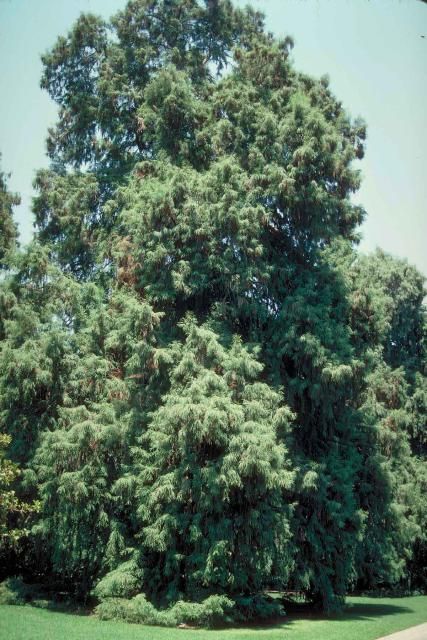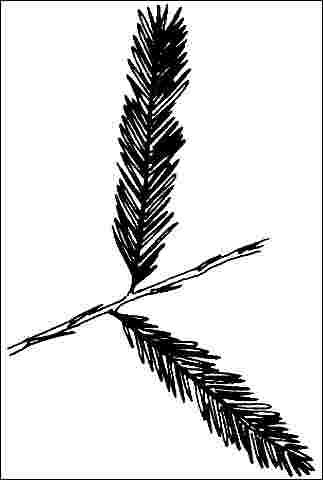Introduction
Montezuma baldcypress, Mexico's national tree, is a huge tree in its native habitat and is pyramidal when young with a dense crown but, like baldcypress, eventually develops into a broad-topped, spreading, open specimen when mature with pendulous branches. Capable of reaching 100 to 150 feet in height, most landscape specimens will reach this height. The pale green, needle-like leaves are only deciduous in the colder sections of its range, remaining evergreen elsewhere. The trunk grows unusually thick toward the base, even on young trees. One of the most vivid examples of this trait is the tule cypress found growing in Oaxaca, Mexico, which sports a trunk diameter of 35 to 40 feet, or a circumference of 115 feet, while the tree itself is only 140 feet tall. This tree has been estimated to be between 2,000 and 5,000 years old.

Credit: Ed Gilman, UF/IFAS
General Information
Scientific name: Taxodium mucronatum
Pronunciation: tack-SO-dee-um mew-kroe-NAY-tum
Common name(s): Montezuma baldcypress, Mexican cypress
Family: Taxodiaceae
USDA hardiness zones: 8B through 11 (Fig. 2)
Origin: native to North America
Uses: specimen; screen; hedge
Availability: not native to North America

Description
Height: 50 to 80 feet
Spread: 25 to 35 feet
Crown uniformity: symmetrical
Crown shape: pyramidal, upright/erect
Crown density: dense
Growth rate: moderate
Texture: fine
Foliage
Leaf arrangement: alternate (Fig. 3)
Leaf type: simple
Leaf margin: entire
Leaf shape: linear, lanceolate
Leaf venation: none, or difficult to see
Leaf type and persistence: evergreen, semi-evergreen
Leaf blade length: less than 2 inches
Leaf color: green
Fall color: no color change
Fall characteristic: not showy

Flower
Flower color: unknown
Flower characteristics: not showy
Fruit
Fruit shape: round, oval, cone
Fruit length: .5 to 1 inch, 1 to 3 inches
Fruit covering: dry or hard
Fruit color: brown
Fruit characteristics: does not attract wildlife; not showy; fruit/leaves not a litter problem
Trunk and Branches
Trunk/bark/branches: branches droop; showy; typically one trunk; thorns
Pruning requirement: little required
Breakage: resistant
Current year twig color: green
Current year twig thickness: thin
Wood specific gravity: unknown
Culture
Light requirement: full sun
Soil tolerances: clay; sand; loam; acidic; slightly alkaline; extended flooding; well-drained
Drought tolerance: moderate
Aerosol salt tolerance: unknown
Other
Roots: not a problem
Winter interest: no
Outstanding tree: no
Ozone sensitivity: unknown
Verticillium wilt susceptibility: resistant
Pest resistance: resistant to pests/diseases
Use and Management
It provides a good vertical accent to the landscape and could be tried in urban areas. The roots probably will not lift sidewalks and curbs as readily as some other species since Baldcypress does not. Its delicate, feathery foliage affords light, dappled shade, and the heartwood of montezuma baldcypress is quite strong and resistant to rot.
Although not truly a swamp tree as other Taxodiums, montezuma baldcypress still grows well in moist soil. Its seeds will only germinate in either water or wet soil. Montezuma baldcypress is relatively maintenance-free, requiring pruning only to remove dead wood and unwanted lower branches which persist on the tree. It maintains a desirably straight trunk and does not form double or multiple leaders as do many other large trees. In the only test that I am aware of in the East, growth was stunted in Auburn University test plots where no irrigation was provided. Since extensive testing of this tree is lacking in the east, plant only a few of them to evaluate adaptability in your area.
Propagation is by seed.
Diseases
Probably no diseases are serious.